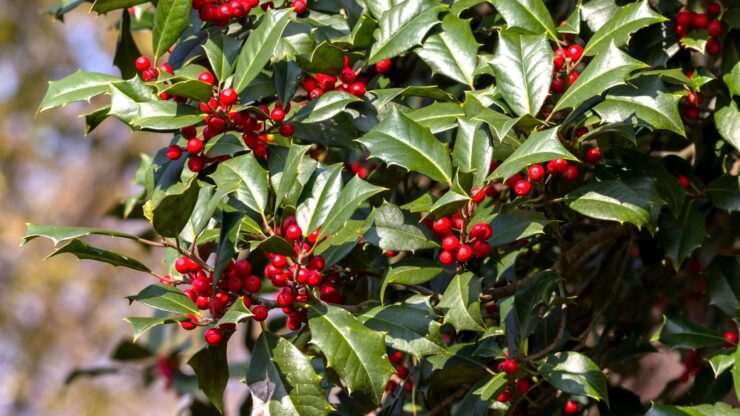American Holly – Ilex opaca: A small to medium-sized tree. Leaves alternate, persistent, simple, 2-4 inches long, and 1-2 inches wide. The leaf margin is wavy with stout, stiff, sharp spines.
Fruit is a spherical red berrylike drupe about .25 inches in diameter, each containing several 1 seeded nutlets.
The bark is Gray and thin with wartlike structures.
Range from Massachusetts to Florida to Texas, Illinois.
Fruit is used extensively by some songbirds and thrashers.
Bark and Growth
The bark of the American holly adds to its unique profile. It is gray and relatively thin, adorned with wartlike structures. These features not only make the tree recognizable but also provide it with a degree of protection from certain environmental factors. The bark’s texture and color can vary slightly depending on the age of the tree and its specific growing conditions.
Geographic Range
The American holly boasts a broad geographic range across the United States. It can be found from Massachusetts in the north to Florida in the south, extending westward to Texas and Illinois. This wide distribution underscores the tree’s adaptability to various climatic conditions and soil types. It thrives in well-drained soils, often favoring locations that provide partial to full sunlight.
Ecological Importance
In addition to its aesthetic appeal, the American holly plays a significant role in its ecosystem. The evergreen leaves provide year-round shelter for various wildlife, including birds and small mammals. The dense foliage offers protection from predators and harsh weather conditions. Furthermore, the berries are a critical food source for birds during winter, supporting the survival of many species during challenging times.
Cultural Significance
Beyond its ecological value, the American holiday holds cultural significance, particularly during the holiday season. Its bright red berries and glossy green leaves have made it a popular choice for Christmas decorations. Holly branches are often used in wreaths, garlands, and other festive displays. This tradition dates back centuries and is rooted in various cultural practices and beliefs.
Conservation and Management
While the American holly is not currently listed as endangered, it is important to manage its populations responsibly. Conservation efforts focus on preserving natural habitats and preventing overharvesting, particularly in areas where the tree is used extensively for decorative purposes. Sustainable harvesting practices and reforestation projects help ensure that this valuable species continues to thrive.
Growing and Care
For those interested in cultivating American holly, understanding its growth requirements is essential. The tree prefers acidic, well-drained soil and can tolerate a range of light conditions from full sun to partial shade. Regular watering is important, especially during the first few years after planting. Pruning should be done carefully to maintain the tree’s shape and health without damaging the spiny leaves.
Pest and Disease Management
American holly is relatively hardy but can be susceptible to certain pests and diseases. Common issues include leaf miners, scale insects, and fungal infections. Regular monitoring and appropriate treatment are necessary to keep the tree healthy. Integrated pest management strategies, including the use of natural predators and organic treatments, can be effective in controlling these problems.
Landscape Uses
In landscaping, American holly is valued for its aesthetic and practical qualities. It can be used as a specimen tree, a hedge, or a screen. Its evergreen nature provides year-round interest and color, while its dense foliage offers privacy and wind protection. The tree’s adaptability makes it a versatile choice for various landscape designs.
Conclusion
The American holly, Ilex opaca, is more than just a tree; it is a vital component of its ecosystem, a cultural symbol, and a versatile addition to landscapes. Understanding its characteristics, ecological role, and cultural significance allows us to appreciate this remarkable species.

